2012年07月25日
MG4 Full Auto Only Firepower
私たちのブログを訪問していただきありがとうございます。あなたがお持ちの場合DIYの要求は私達に電子メールを送信してください。
Germany’s armed forces adopt HK’s new 5.56mm MG4 lightweight squad auto!
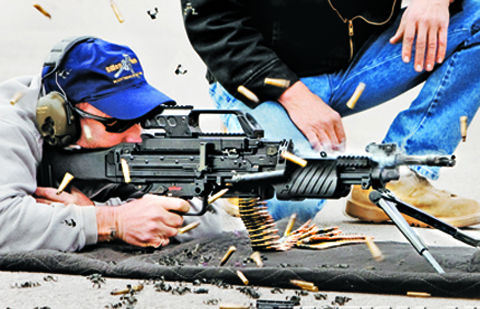
German gun maker Heckler & Koch (HK) is well known for breaking molds. The engineers in Oberndorf are not afraid to blaze new trails with guns like the G36 assault rifle with its polymer construction and integral optics. Note I said “optics,” plural: The G36A1 sports both a red-dot sight and a 4X scope stacked on top each other in a sort of figure 8.
When it came time to upgrade the army’s squad machinegun, the Bundeswehr naturally turned to HK to develop a weapon. Yes, the Germans could have bought M249 SAWs from FN in neighboring Belgium, but that’s not how they operate in Europe’s foremost manufacturing country. The Bundeswehr wanted a German gun. I can’t blame them at all. In a quick digression, I note with alarm that America’s military cares not a whit about sustaining our own domestic small-arms development capability.
We bought Beretta pistols from Italy. We awarded FN the contract to develop the SCAR. Glock pistols were recently bought by the hundreds of thousands to give to Iraqi cops. I would like to see our military try a little “buy at home” for a change, like the Germans do.
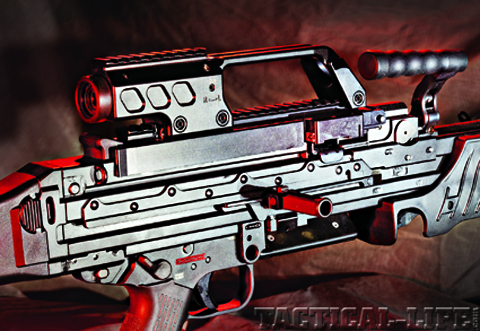
And so HK was tasked with developing a SAW-like weapon: a belt-fed 5.56mm light machinegun that can be adapted for an assault mode as well as a fixed position mode (i.e., tripod mounted). The result was the MG43 which first appeared in 2001 and was later type-classified and adopted by the Budeswehr as the MG4. By 2007, the MG4 had replaced the previous MG3, a 7.62mm machinegun, on vehicles and for ground troops.
The MG4 is a definite departure for HK as it’s a conventional gas-operated, rotary cam design whereas previous German machineguns have relied on the distinctive Vorgrimler-designed roller-delayed blowback action.
BLOG ARCHIVES

Germany’s armed forces adopt HK’s new 5.56mm MG4 lightweight squad auto!

German gun maker Heckler & Koch (HK) is well known for breaking molds. The engineers in Oberndorf are not afraid to blaze new trails with guns like the G36 assault rifle with its polymer construction and integral optics. Note I said “optics,” plural: The G36A1 sports both a red-dot sight and a 4X scope stacked on top each other in a sort of figure 8.
When it came time to upgrade the army’s squad machinegun, the Bundeswehr naturally turned to HK to develop a weapon. Yes, the Germans could have bought M249 SAWs from FN in neighboring Belgium, but that’s not how they operate in Europe’s foremost manufacturing country. The Bundeswehr wanted a German gun. I can’t blame them at all. In a quick digression, I note with alarm that America’s military cares not a whit about sustaining our own domestic small-arms development capability.
We bought Beretta pistols from Italy. We awarded FN the contract to develop the SCAR. Glock pistols were recently bought by the hundreds of thousands to give to Iraqi cops. I would like to see our military try a little “buy at home” for a change, like the Germans do.

And so HK was tasked with developing a SAW-like weapon: a belt-fed 5.56mm light machinegun that can be adapted for an assault mode as well as a fixed position mode (i.e., tripod mounted). The result was the MG43 which first appeared in 2001 and was later type-classified and adopted by the Budeswehr as the MG4. By 2007, the MG4 had replaced the previous MG3, a 7.62mm machinegun, on vehicles and for ground troops.
The MG4 is a definite departure for HK as it’s a conventional gas-operated, rotary cam design whereas previous German machineguns have relied on the distinctive Vorgrimler-designed roller-delayed blowback action.
BLOG ARCHIVES

Posted by echigoyaworks
at 16:00
2012年07月25日
D&L Sports Perimeter Carbine 5.56mm
私たちのブログを訪問していただきありがとうございます。あなたがお持ちの場合DIYの要求は私達に電子メールを送信してください。
Extremely high-precision downrange dominator with sniper rifle accuracy!
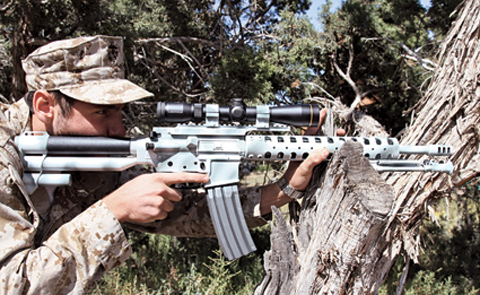
This U.S. Marine loved the D&L PPC and the SureFire 60-round mag shown here. He will soon deploy and wishes he could take both with him.
Quite alive and well, the old slogan “buyer beware” pertains to, well, everything we buy. A life-long, daily risk management drill, you ask? You bet, and firearms are certainly no exception. Take the AR-15 platform, but don’t try to count all the clones or you may hurt your eyes, as they can run the gamut of the good, bad and the ugly. Did you hear about the small quantity of aftermarket ARs last year that were equipped with bolts made in Turkey? Except for the bolts, the guns were fine. Sure, you can cut corners, but not at the corner of “bolt and carrier.” When you do, a big accident is waiting to happen.
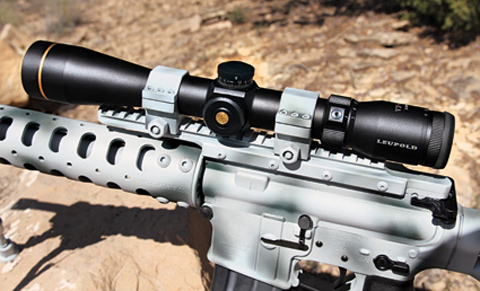
Using four mounting bolts, D&L’s receiver scope base is extremely secure, as is its eight-bolt handguard and 60-screw 30mm scope rings.
Case in point, an accident occurred while in the hands of a police officer who was the (short-lived) proud owner of the new AR clone. Fortunately, God was at the range when all six lugs sheered off, allowing the bolt to blow rearward without rotating. The upper receiver was destroyed and all other upper parts, except the barrel, were ready for a dirt nap. The lower suffered no damage and, most importantly, the police officer suffered only a face speckled by tiny aluminum shards, with his glasses saving his eyes. Yes, you can get what you pay for, but sometimes it’s worth less than the asking price.

Even without its winter plumage, D&L’s Professional Perimeter Carbine would stand out in a crowd. Many of its features are unique to D&L Sports, including its aluminum stock, free-floating, ventilated handguard, and muzzle brake/flash suppressor. The scope tested with the rifle was a Leupold 3-9×42mm.
When compared with some, the AR-15-type rifle is a highly technical rifle; not only in design, but also in the mil-spec requirements assuring that it is made of the finest materials to the highest quality control. It isn’t rocket science, but it is vital to the operation and safety of rifle and operator.

Built to endure harsh usage, D&L’s aluminum AR buttstock comes with two waterproof storage tubes. They also make an adjustable length-of-pull version.
BLOG ARCHIVES

Extremely high-precision downrange dominator with sniper rifle accuracy!

This U.S. Marine loved the D&L PPC and the SureFire 60-round mag shown here. He will soon deploy and wishes he could take both with him.
Quite alive and well, the old slogan “buyer beware” pertains to, well, everything we buy. A life-long, daily risk management drill, you ask? You bet, and firearms are certainly no exception. Take the AR-15 platform, but don’t try to count all the clones or you may hurt your eyes, as they can run the gamut of the good, bad and the ugly. Did you hear about the small quantity of aftermarket ARs last year that were equipped with bolts made in Turkey? Except for the bolts, the guns were fine. Sure, you can cut corners, but not at the corner of “bolt and carrier.” When you do, a big accident is waiting to happen.

Using four mounting bolts, D&L’s receiver scope base is extremely secure, as is its eight-bolt handguard and 60-screw 30mm scope rings.
Case in point, an accident occurred while in the hands of a police officer who was the (short-lived) proud owner of the new AR clone. Fortunately, God was at the range when all six lugs sheered off, allowing the bolt to blow rearward without rotating. The upper receiver was destroyed and all other upper parts, except the barrel, were ready for a dirt nap. The lower suffered no damage and, most importantly, the police officer suffered only a face speckled by tiny aluminum shards, with his glasses saving his eyes. Yes, you can get what you pay for, but sometimes it’s worth less than the asking price.

Even without its winter plumage, D&L’s Professional Perimeter Carbine would stand out in a crowd. Many of its features are unique to D&L Sports, including its aluminum stock, free-floating, ventilated handguard, and muzzle brake/flash suppressor. The scope tested with the rifle was a Leupold 3-9×42mm.
When compared with some, the AR-15-type rifle is a highly technical rifle; not only in design, but also in the mil-spec requirements assuring that it is made of the finest materials to the highest quality control. It isn’t rocket science, but it is vital to the operation and safety of rifle and operator.

Built to endure harsh usage, D&L’s aluminum AR buttstock comes with two waterproof storage tubes. They also make an adjustable length-of-pull version.
BLOG ARCHIVES

Posted by echigoyaworks
at 10:00
2012年07月24日
Springfield .45 Professional
私たちのブログを訪問していただきありがとうございます。あなたがお持ちの場合DIYの要求は私達に電子メールを送信してください。
Fighting 1911 that overcame rigorous testing to become the FBI’s “go-to” tactical pistol!
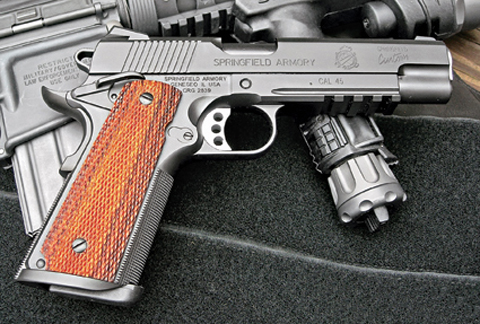
Every feature of the Professional Model was specified in the RFP by the Bureau, and each submission for the original FBI contract was required to meet demanding endurance and accuracy requirements.
When the FBI adopted the Springfield Professional 1911 in 1998, new respect was bestowed on the old workhorse. The Professional is the result of a Request for Proposal (RFP) that was issued in 1995 in an effort to standardize the pistol for all of their regional SWAT operators. The RFP was extremely demanding and considered by some to be unreasonable. While half a dozen or so manufacturers and shops submitted guns, there would only be one winner. One of those vying for a chance at the contract was Dave Williams, Springfield’s Custom Shop Director.
Origins
At first glance, the Professional may not seem all that unique or different but, in 1998, it set the world on fire. After all, the country’s “premier law enforcement agency” had chosen a design that was some 90 years old. For those who are not familiar with this pistol, the Professional Model is a single-stack 1911 pistol that is built entirely in Springfield’s Custom Shop. The slide and frame start as semi-finished parts and the shop’s staff cut the rails, drill the pin holes and hand fit every part.
The Bureau specified Novak low-mount tritium sights, an extended ambidextrous safety, beavertail grip safety, magazine well, 20-lines-per-inch checkered frontstrap, and match-grade internal components. The proposal also called for Walter Birdsong’s Black- T finish and required the pistols to be shipped with five Wilson 47D 8-round magazines. On top of all this, the manufacturer was required to warranty the pistol for an astounding 50,000 rounds.
BLOG ARCHIVES

Fighting 1911 that overcame rigorous testing to become the FBI’s “go-to” tactical pistol!

Every feature of the Professional Model was specified in the RFP by the Bureau, and each submission for the original FBI contract was required to meet demanding endurance and accuracy requirements.
When the FBI adopted the Springfield Professional 1911 in 1998, new respect was bestowed on the old workhorse. The Professional is the result of a Request for Proposal (RFP) that was issued in 1995 in an effort to standardize the pistol for all of their regional SWAT operators. The RFP was extremely demanding and considered by some to be unreasonable. While half a dozen or so manufacturers and shops submitted guns, there would only be one winner. One of those vying for a chance at the contract was Dave Williams, Springfield’s Custom Shop Director.
Origins
At first glance, the Professional may not seem all that unique or different but, in 1998, it set the world on fire. After all, the country’s “premier law enforcement agency” had chosen a design that was some 90 years old. For those who are not familiar with this pistol, the Professional Model is a single-stack 1911 pistol that is built entirely in Springfield’s Custom Shop. The slide and frame start as semi-finished parts and the shop’s staff cut the rails, drill the pin holes and hand fit every part.
The Bureau specified Novak low-mount tritium sights, an extended ambidextrous safety, beavertail grip safety, magazine well, 20-lines-per-inch checkered frontstrap, and match-grade internal components. The proposal also called for Walter Birdsong’s Black- T finish and required the pistols to be shipped with five Wilson 47D 8-round magazines. On top of all this, the manufacturer was required to warranty the pistol for an astounding 50,000 rounds.
BLOG ARCHIVES

Posted by echigoyaworks
at 21:00
2012年07月24日
Sionics Weapon Systems SAR -15-QR10
私たちのブログを訪問していただきありがとうございます。あなたがお持ちの場合DIYの要求は私達に電子メールを送信してください。
Designed by operators for operators with all the features that patrol officers need!

The Sionics SAR-15-QR10 offers true no-nonsense Mil-Spec quality at the right price for today’s law enforcement needs. It is shown equipped with an EOTech 553.A65TAN HWS and Atlas Precision BT10 bipod.
Sionics Weapon Systems is a fairly new AR rifle manufacturer that is committed to delivering the highest quality Mil-Spec no-nonsense guns at the lowest possible price. And judging by its SAR-15-QR10 rifle, I would say they have succeeded.
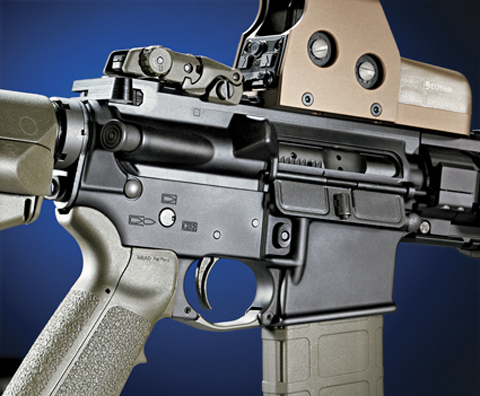
Sionics SAR-15-QR10 exhibited tight tolerances between the upper and lower receivers and an excellent finish.
The staff and management at Sionics is made up of former military and law enforcement personnel who know what it means to depend on your weapon system. Josh Ellis, the owner of Sionics, has worked closely with many police armorers to ensure that his rifle meets their needs. It has been extensively tested and approved by the Tucson Police Department as a patrol rifle. According to Ellis, Sionics rifles are being used by federal agents as well as being currently evaluated by several law enforcement agencies.
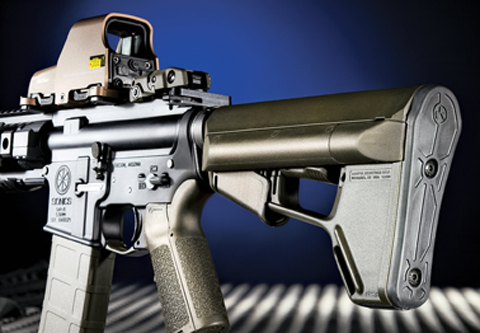
The SAR-15-QR10 sports an olive drab Magpul ACS carbine stock, MIAD pistol grip, MOE enlarged triggerguard, XTM rail panels, PMag and MBUS flip-up front and rear sights.
The SAR-15 is a direct gas impingement 5.56mm NATO semi-auto rifle exhibiting above standard quality. The fit and finish and attention to detail are equivalent to what one would expect from a custom gun shop and with some extras as well.
BLOG ARCHIVES

Designed by operators for operators with all the features that patrol officers need!

The Sionics SAR-15-QR10 offers true no-nonsense Mil-Spec quality at the right price for today’s law enforcement needs. It is shown equipped with an EOTech 553.A65TAN HWS and Atlas Precision BT10 bipod.
Sionics Weapon Systems is a fairly new AR rifle manufacturer that is committed to delivering the highest quality Mil-Spec no-nonsense guns at the lowest possible price. And judging by its SAR-15-QR10 rifle, I would say they have succeeded.

Sionics SAR-15-QR10 exhibited tight tolerances between the upper and lower receivers and an excellent finish.
The staff and management at Sionics is made up of former military and law enforcement personnel who know what it means to depend on your weapon system. Josh Ellis, the owner of Sionics, has worked closely with many police armorers to ensure that his rifle meets their needs. It has been extensively tested and approved by the Tucson Police Department as a patrol rifle. According to Ellis, Sionics rifles are being used by federal agents as well as being currently evaluated by several law enforcement agencies.

The SAR-15-QR10 sports an olive drab Magpul ACS carbine stock, MIAD pistol grip, MOE enlarged triggerguard, XTM rail panels, PMag and MBUS flip-up front and rear sights.
The SAR-15 is a direct gas impingement 5.56mm NATO semi-auto rifle exhibiting above standard quality. The fit and finish and attention to detail are equivalent to what one would expect from a custom gun shop and with some extras as well.
BLOG ARCHIVES

Posted by echigoyaworks
at 16:00
2012年07月24日
Wilson Combat SBR Tactical 7.62×40 WT
私たちのブログを訪問していただきありがとうございます。あなたがお持ちの場合DIYの要求は私達に電子メールを送信してください。
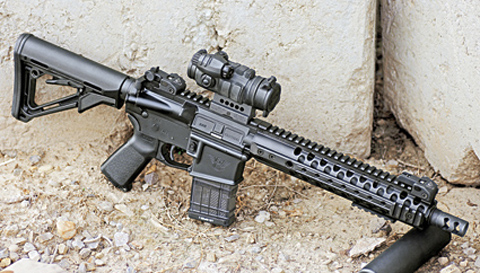
Wilson Combat’s SBR Tactical is extremely powerful yet easy to maneuver with in close quarters. Wilson’s proprietary 7.62×40 WT cartridge has just the right amount of knockdown power to pair with the SBR’s barrel. This is truly a versatile platform. Shown here with an Aimpoint CompM3.
New chamberings come and go all the time, and this has always been the nature of the business. Someone is always trying to improve on existing cartridges, platforms and systems. It is this innovation that makes the firearms industry as strong as it is.
One of the longest standing of these projects has been the short .30 caliber for the AR platform. Since the first time a U.S. soldier fought against the AK-47 and its 7.62×39mm cartridge, the industry has tried to make that round (or one like it) work in an AR. It is a project that continues to this day, resulting in cartridges like the 300 AAC Blackout, .300 Whisper and a few others. They are all an attempt to approximate the ballistics of the 7.62×39mm and function properly in an AR-type rifle. For most, that is as close to 2,400 feet per second (fps) as you can get with a 125-grain bullet. New powders, bullets and precise manufacturing have made this better with each passing year. But getting these cartridges to fire has never really been the issue—it has been getting them to work in magazines.

The Wilson Combat Whisper762 suppressor does little to affect the balance of the SBR Tactical—it’s lightweight, quiet, and reliable. During range tests, the suppressor showed no signs of shifting the point of impact. It provided minimal backpressure, never came loose, and maintained excellent sound suppression.
Take a close look at an AK-47 magazine. It curves almost immediately. Other than the lip of the magazine, about an inch or so, it is one continuous curve. This is necessary for the ammunition to feed properly past about ten rounds, given the cartridge diameter. You could make a straight magazine, of course, but it would be too long to be practical, and still presents its own set of issues. You need the curve in order to make it practical with a 30-round magazine—even for a 20- or 25-rounder. Without this curve, the rounds will bunch up in the middle and cause malfunctions. It is just one of those laws of physics that cannot be circumvented.

Wilson builds their SBR with their TTU (Tactical Trigger Unit), which provides operators with a clean two-stage trigger.
BLOG ARCHIVES


Wilson Combat’s SBR Tactical is extremely powerful yet easy to maneuver with in close quarters. Wilson’s proprietary 7.62×40 WT cartridge has just the right amount of knockdown power to pair with the SBR’s barrel. This is truly a versatile platform. Shown here with an Aimpoint CompM3.
New chamberings come and go all the time, and this has always been the nature of the business. Someone is always trying to improve on existing cartridges, platforms and systems. It is this innovation that makes the firearms industry as strong as it is.
One of the longest standing of these projects has been the short .30 caliber for the AR platform. Since the first time a U.S. soldier fought against the AK-47 and its 7.62×39mm cartridge, the industry has tried to make that round (or one like it) work in an AR. It is a project that continues to this day, resulting in cartridges like the 300 AAC Blackout, .300 Whisper and a few others. They are all an attempt to approximate the ballistics of the 7.62×39mm and function properly in an AR-type rifle. For most, that is as close to 2,400 feet per second (fps) as you can get with a 125-grain bullet. New powders, bullets and precise manufacturing have made this better with each passing year. But getting these cartridges to fire has never really been the issue—it has been getting them to work in magazines.

The Wilson Combat Whisper762 suppressor does little to affect the balance of the SBR Tactical—it’s lightweight, quiet, and reliable. During range tests, the suppressor showed no signs of shifting the point of impact. It provided minimal backpressure, never came loose, and maintained excellent sound suppression.
Take a close look at an AK-47 magazine. It curves almost immediately. Other than the lip of the magazine, about an inch or so, it is one continuous curve. This is necessary for the ammunition to feed properly past about ten rounds, given the cartridge diameter. You could make a straight magazine, of course, but it would be too long to be practical, and still presents its own set of issues. You need the curve in order to make it practical with a 30-round magazine—even for a 20- or 25-rounder. Without this curve, the rounds will bunch up in the middle and cause malfunctions. It is just one of those laws of physics that cannot be circumvented.

Wilson builds their SBR with their TTU (Tactical Trigger Unit), which provides operators with a clean two-stage trigger.
BLOG ARCHIVES

Posted by echigoyaworks
at 10:00
2012年07月23日
Marine Air Wing using Leupold HAMR
私たちのブログを訪問していただきありがとうございます。あなたがお持ちの場合DIYの要求は私達に電子メールを送信してください。

Apparently the Marine Air Wing, America's Navy's Army's Air Force, are using the new Leupold HAMR scope. Its combination of long eye relief and compact size make it a good choice for ariel overwatch. The Marine Air Wingers also appear to be Magpul fans, using Magpul stocks and magazines.
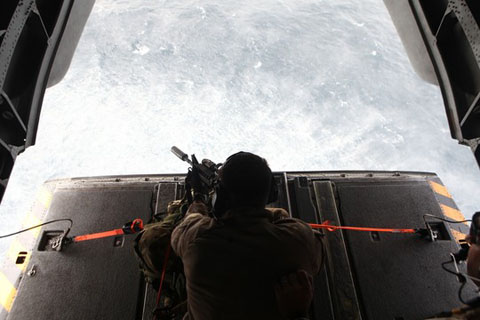
The Leupold HAMR is said to be part of the SOPMOD Block II kit which is currently under development.
BLOG ARCHIVES


Apparently the Marine Air Wing, America's Navy's Army's Air Force, are using the new Leupold HAMR scope. Its combination of long eye relief and compact size make it a good choice for ariel overwatch. The Marine Air Wingers also appear to be Magpul fans, using Magpul stocks and magazines.

The Leupold HAMR is said to be part of the SOPMOD Block II kit which is currently under development.
BLOG ARCHIVES

Posted by echigoyaworks
at 21:00
2012年07月23日
Nemesis Vanquish
私たちのブログを訪問していただきありがとうございます。あなたがお持ちの場合DIYの要求は私達に電子メールを送信してください。
From up-armored briefcase to DOA precision in 60 seconds or less!
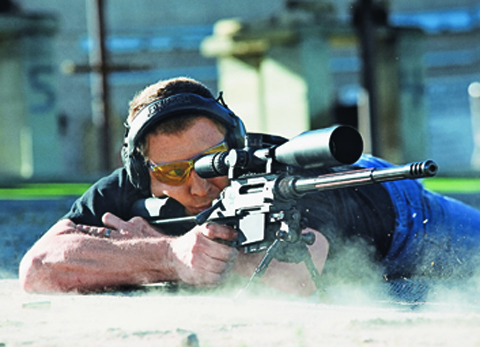
For many years, the .308 Winchester has been a major cartridge of choice for snipers. Combined with the Vanquish, the .308 Win. improves your odds for precise, long-range hits.
Since the American Revolution, our military has used the marksman, a sniper in today’s terminology, to great effect on the battlefield. It may not have been considered gentlemanly at the time, especially by the neat phalanxes of Redcoats who complained about the rebels fighting from behind concealment and cover like Indians, but the results would override any objections. By the American Civil War, the marksman was entrenched in the tactics of warfare with his properties of stealth and long-range accuracy. Enemies were no longer safe even far from the frontlines. Over time, the mission of the sniper has basically stayed the same, aside from also being tasked as a scout or observer because of his forward deployment, but there have been changes in both his methods and equipment. The most notable changes have been made to the sniper’s main weapon, the rifle.
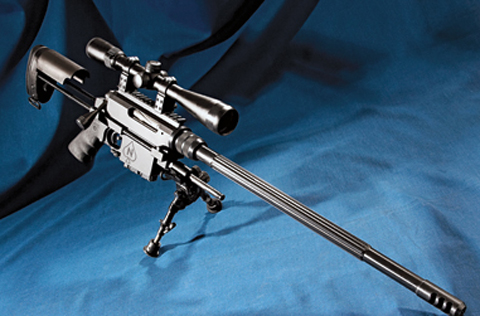
The Vanquish is a purpose-built rifle with all components tuned to provide the best function and accuracy. It may look stark, but it will bring out the best in the ammunition and the shooter.
The marksmen of the Revolution mainly used their personal firearms, most often hunting rifles, because they were more accurate than the military muskets of the day. Over the years, improvement to military arms has led to improvement in sporting arms and vice versa, to the point where the sniper’s rifle has usually been one of two types: either a sporting arm adapted to handle the rigors of the battlefield, or a military rifle modified to improve accuracy. Only towards the end of the 20th century did we see rifles that were purpose-built for use by the American sniper. I am not talking about the Remington 700s or the Winchester 70s, since these were sporting rifles at birth, but the larger .50-caliber rifles built by firms such as Barrett.
It is in this arena of modern weapons that Nemesis Arms has made a grand entrance with the manufacture of the Vanquish. The Vanquish is designed from the ground up as the ultimate mid-caliber weapon for the modern sniper.
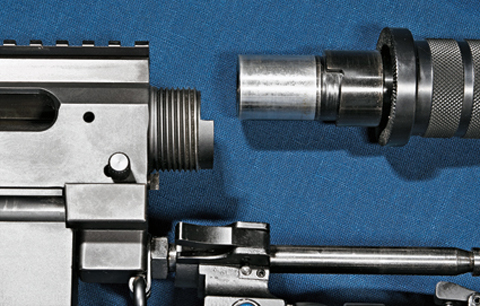
The barrel is a slip-fit into the receiver and then held in place by a threaded nut. The spring-loaded plunger, seen below the threads, assures everything stays together.
BLOG ARCHIVES

From up-armored briefcase to DOA precision in 60 seconds or less!

For many years, the .308 Winchester has been a major cartridge of choice for snipers. Combined with the Vanquish, the .308 Win. improves your odds for precise, long-range hits.
Since the American Revolution, our military has used the marksman, a sniper in today’s terminology, to great effect on the battlefield. It may not have been considered gentlemanly at the time, especially by the neat phalanxes of Redcoats who complained about the rebels fighting from behind concealment and cover like Indians, but the results would override any objections. By the American Civil War, the marksman was entrenched in the tactics of warfare with his properties of stealth and long-range accuracy. Enemies were no longer safe even far from the frontlines. Over time, the mission of the sniper has basically stayed the same, aside from also being tasked as a scout or observer because of his forward deployment, but there have been changes in both his methods and equipment. The most notable changes have been made to the sniper’s main weapon, the rifle.

The Vanquish is a purpose-built rifle with all components tuned to provide the best function and accuracy. It may look stark, but it will bring out the best in the ammunition and the shooter.
The marksmen of the Revolution mainly used their personal firearms, most often hunting rifles, because they were more accurate than the military muskets of the day. Over the years, improvement to military arms has led to improvement in sporting arms and vice versa, to the point where the sniper’s rifle has usually been one of two types: either a sporting arm adapted to handle the rigors of the battlefield, or a military rifle modified to improve accuracy. Only towards the end of the 20th century did we see rifles that were purpose-built for use by the American sniper. I am not talking about the Remington 700s or the Winchester 70s, since these were sporting rifles at birth, but the larger .50-caliber rifles built by firms such as Barrett.
It is in this arena of modern weapons that Nemesis Arms has made a grand entrance with the manufacture of the Vanquish. The Vanquish is designed from the ground up as the ultimate mid-caliber weapon for the modern sniper.

The barrel is a slip-fit into the receiver and then held in place by a threaded nut. The spring-loaded plunger, seen below the threads, assures everything stays together.
BLOG ARCHIVES

Posted by echigoyaworks
at 16:00
2012年07月23日
KAC’s SR-25 U.S. SPEC OPS
私たちのブログを訪問していただきありがとうございます。あなたがお持ちの場合DIYの要求は私達に電子メールを送信してください。
With the BulletFlight iPod app, marksmen have 900M, cold-bore accuracy in the palm of their hands!
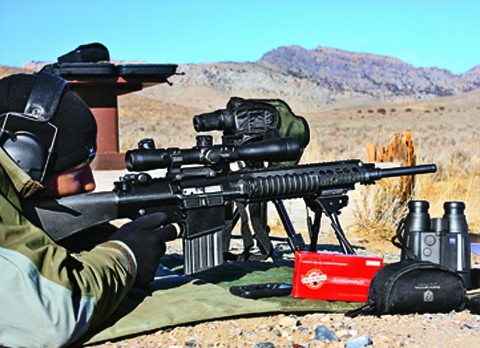
The semi-automatic action allows operators to engage multiple targets. Its similarity in appearance to a standard M-16 diminishes the likelihood of an enemy’s observation of a sniper’s presence during insertions with friendly patrols.
The SR-25 is the weapon platform that ushered in, or was rather a product of, a paradigm shift in the U.S. military’s thinking on sniper weapons. KAC’s (Knight’s Armament Company) SR-25 system has come to the battlefield and provides U.S. Special Operations Forces an accurate, semi-automatic platform with bolt-gun accuracy on multiple targets out to 800 meters, and eliminates the need for snipers to carry a defensive second rifle. Built into the familiar Stoner/AR design, the SR-25 can deliver five shots in five seconds and carries a 20-round magazine, thus surpassing the bolt-action rifle in both rate and duration of fire.
Chambered for the 7.62×51mm (.308) round, the SR-25’s design is both an extension of existing weapons development and a radical step forward. To support and extend the rifle’s battlefield sustainability, 60% of the parts are interchangeable with the AR-15/M16 system. Significant changes begin with the free-floating, match grade barrel that is now delivered in a 20-inch Obermeyer steel alloy and 16-inch chrome plated versions capable of sustained .5 MOA accuracy. The rotating bolt and direct-impingement gas system is based on Eugene Stoner’s designs and evolved further by C. Reed Knight, Jr. In order to both protect the free-floating barrel and accommodate sighting and rail mounted devices, KAC developed the Rail Adapter System II Upper Receiver Extension (RASIIURX). While slight variations exist between the Army, Navy and Marine Corp packages, the SR-25 system is typically outfitted with the 3.5-10×40mm Leupold Mk IV mil-dot scope, Harris bipod and KAC QD suppressor. Variants delivered to U.S. forces include more than 3,000 of the U.S. Army’s M110 SASS (Semi-Automatic Sniper System) and the 3,500 of U.S. Navy’s and Marine Corp’s Mk 11 Mod 0, 1&2. These deliveries are not only for use in the scout/sniper ranks, but are also finding themselves in the grateful hands of an increasing number of Designated Marksmen. Other branches of the U.S. government including the Department of State and Department of Energy have also adopted versions for their respective missions. Both in the hands of the trained sniper and the Designated Marksman, the SR-25 variants have seen direct action with Allied forces for more than six years. David Jones, a retired SEAL sniper who carried the Mk11 Mod 0 throughout two tours in Afghanistan, consistently had 1MOA accuracy out to 1,100 yards.
BLOG ARCHIVES

With the BulletFlight iPod app, marksmen have 900M, cold-bore accuracy in the palm of their hands!

The semi-automatic action allows operators to engage multiple targets. Its similarity in appearance to a standard M-16 diminishes the likelihood of an enemy’s observation of a sniper’s presence during insertions with friendly patrols.
The SR-25 is the weapon platform that ushered in, or was rather a product of, a paradigm shift in the U.S. military’s thinking on sniper weapons. KAC’s (Knight’s Armament Company) SR-25 system has come to the battlefield and provides U.S. Special Operations Forces an accurate, semi-automatic platform with bolt-gun accuracy on multiple targets out to 800 meters, and eliminates the need for snipers to carry a defensive second rifle. Built into the familiar Stoner/AR design, the SR-25 can deliver five shots in five seconds and carries a 20-round magazine, thus surpassing the bolt-action rifle in both rate and duration of fire.
Chambered for the 7.62×51mm (.308) round, the SR-25’s design is both an extension of existing weapons development and a radical step forward. To support and extend the rifle’s battlefield sustainability, 60% of the parts are interchangeable with the AR-15/M16 system. Significant changes begin with the free-floating, match grade barrel that is now delivered in a 20-inch Obermeyer steel alloy and 16-inch chrome plated versions capable of sustained .5 MOA accuracy. The rotating bolt and direct-impingement gas system is based on Eugene Stoner’s designs and evolved further by C. Reed Knight, Jr. In order to both protect the free-floating barrel and accommodate sighting and rail mounted devices, KAC developed the Rail Adapter System II Upper Receiver Extension (RASIIURX). While slight variations exist between the Army, Navy and Marine Corp packages, the SR-25 system is typically outfitted with the 3.5-10×40mm Leupold Mk IV mil-dot scope, Harris bipod and KAC QD suppressor. Variants delivered to U.S. forces include more than 3,000 of the U.S. Army’s M110 SASS (Semi-Automatic Sniper System) and the 3,500 of U.S. Navy’s and Marine Corp’s Mk 11 Mod 0, 1&2. These deliveries are not only for use in the scout/sniper ranks, but are also finding themselves in the grateful hands of an increasing number of Designated Marksmen. Other branches of the U.S. government including the Department of State and Department of Energy have also adopted versions for their respective missions. Both in the hands of the trained sniper and the Designated Marksman, the SR-25 variants have seen direct action with Allied forces for more than six years. David Jones, a retired SEAL sniper who carried the Mk11 Mod 0 throughout two tours in Afghanistan, consistently had 1MOA accuracy out to 1,100 yards.
BLOG ARCHIVES

Posted by echigoyaworks
at 10:00
2012年07月22日
.50 BMGs Battle
私たちのブログを訪問していただきありがとうございます。あなたがお持ちの場合DIYの要求は私達に電子メールを送信してください。
Air Force snipers help TW find the big bore that packs all the right punch!
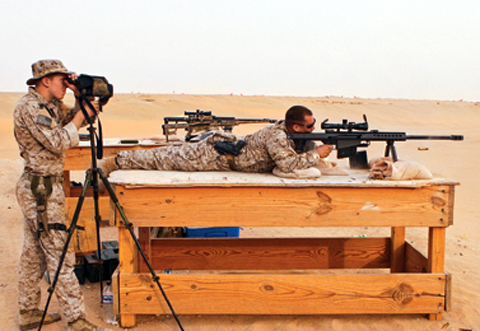
Barrett’s M107 operating system allows the rifle to function reliably in the harshest environments. U.S. Marine Corps Sgt. Daniel Price, left, a team leader with 3rd Platoon, Alpha Company, 1st Marine Reconnaissance Battalion, 13th Marine Expeditionary Unit, spots impacts down range for Gunnery Sgt. David Lind, a platoon sergeant with 3rd Platoon, Alpha Company, 1st Marine Reconnaissance Battalion, 13th Marine Expeditionary Unit, while he zeros his .50-caliber M107 special applications scoped rifle from an unknown distance on Udari range, Kuwait. (U.S. Marine Corps photo by Lance Cpl. Kyle J. Keathley) (Released)
Bushmaster BA50
Bushmaster entered into the .50 BMG realm a few years ago by offering the BA50. Just like every precision bolt-action .50 BMG rifle on the market, the BA50 is built to tolerances and specifications that allow sub-MOA capabilities. Its overall length is 58 inches, and the rifle weighs in at 33 pounds with a 30-inch Lothar Walther barrel and 10-round magazine. The muzzle velocity averages 2,945 FPS with standard military M33 ball ammunition with 661-grain projectiles, and the rifle comes with a full-length Picatinny rail that runs the entire length of the forearm to accommodate night optics. Assembly of the BA50 is one of the simplest on the market for dedicated bolt-action .50 BMG rifles. Similar to the AR design, the upper receiver locks on to the lower receiver with two pins integral to the lower receiver.
The BA50 is hammer-fired, similar to the AR design, easing maintenance and aiding in reliability. Accuracy relies heavily on locking consistency and support of the cartridge and projectile. Tighter tolerances in the chamber area allow for a more consistent expansion of the cartridge as the powders ignite. The BA50 allows for a higher accuracy standard with a more modular chassis.
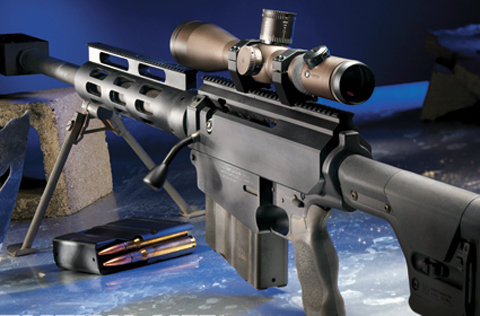
With high-quality glass mounted on Bushmaster’s .50-caliber beast, it’s a machine ready for anti-materiel and EOD disposal missions.
Barrett’s .50 BMG
Currently, the only mainstream, widely used semi-automatic, shoulder-fired .50 BMG rifle is the Barrett M82A1/M107. The weapon system functions via a short recoil operating system, similar to the Browning M2 machine gun chambered in the same cartridge. This creates an excessive amount of movement in the rifle, lowering the accuracy expectations to 2.5 MOA (or larger depending on how the firing position is set up). But it does utilize a 10-round magazine, allowing for a higher rate of fire, and has been proven to be extremely reliable in rugged environments. Military units around the world run this rifle platform and it has been extremely effective on the battlefields of Afghanistan and Iraq.
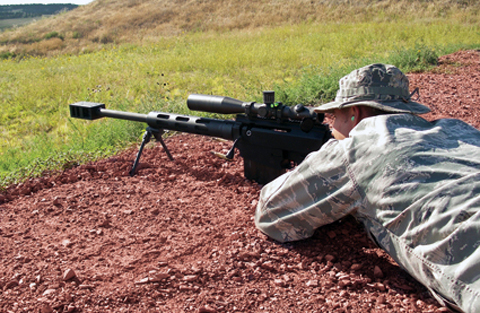
Designed for sub-MOA accuracy and with tight tolerances, the bolt-action Bushmaster BA50 is a very capable sniper rifle.
BLOG ARCHIVES

Air Force snipers help TW find the big bore that packs all the right punch!

Barrett’s M107 operating system allows the rifle to function reliably in the harshest environments. U.S. Marine Corps Sgt. Daniel Price, left, a team leader with 3rd Platoon, Alpha Company, 1st Marine Reconnaissance Battalion, 13th Marine Expeditionary Unit, spots impacts down range for Gunnery Sgt. David Lind, a platoon sergeant with 3rd Platoon, Alpha Company, 1st Marine Reconnaissance Battalion, 13th Marine Expeditionary Unit, while he zeros his .50-caliber M107 special applications scoped rifle from an unknown distance on Udari range, Kuwait. (U.S. Marine Corps photo by Lance Cpl. Kyle J. Keathley) (Released)
Bushmaster BA50
Bushmaster entered into the .50 BMG realm a few years ago by offering the BA50. Just like every precision bolt-action .50 BMG rifle on the market, the BA50 is built to tolerances and specifications that allow sub-MOA capabilities. Its overall length is 58 inches, and the rifle weighs in at 33 pounds with a 30-inch Lothar Walther barrel and 10-round magazine. The muzzle velocity averages 2,945 FPS with standard military M33 ball ammunition with 661-grain projectiles, and the rifle comes with a full-length Picatinny rail that runs the entire length of the forearm to accommodate night optics. Assembly of the BA50 is one of the simplest on the market for dedicated bolt-action .50 BMG rifles. Similar to the AR design, the upper receiver locks on to the lower receiver with two pins integral to the lower receiver.
The BA50 is hammer-fired, similar to the AR design, easing maintenance and aiding in reliability. Accuracy relies heavily on locking consistency and support of the cartridge and projectile. Tighter tolerances in the chamber area allow for a more consistent expansion of the cartridge as the powders ignite. The BA50 allows for a higher accuracy standard with a more modular chassis.

With high-quality glass mounted on Bushmaster’s .50-caliber beast, it’s a machine ready for anti-materiel and EOD disposal missions.
Barrett’s .50 BMG
Currently, the only mainstream, widely used semi-automatic, shoulder-fired .50 BMG rifle is the Barrett M82A1/M107. The weapon system functions via a short recoil operating system, similar to the Browning M2 machine gun chambered in the same cartridge. This creates an excessive amount of movement in the rifle, lowering the accuracy expectations to 2.5 MOA (or larger depending on how the firing position is set up). But it does utilize a 10-round magazine, allowing for a higher rate of fire, and has been proven to be extremely reliable in rugged environments. Military units around the world run this rifle platform and it has been extremely effective on the battlefields of Afghanistan and Iraq.

Designed for sub-MOA accuracy and with tight tolerances, the bolt-action Bushmaster BA50 is a very capable sniper rifle.
BLOG ARCHIVES

Posted by echigoyaworks
at 19:00
2012年07月22日
Dynamic Warriors
私たちのブログを訪問していただきありがとうございます。あなたがお持ちの場合DIYの要求は私達に電子メールを送信してください。
Run the gun and your mind through Magpul’s high-speed, low-drag carbine course with today’s top tactical operators!
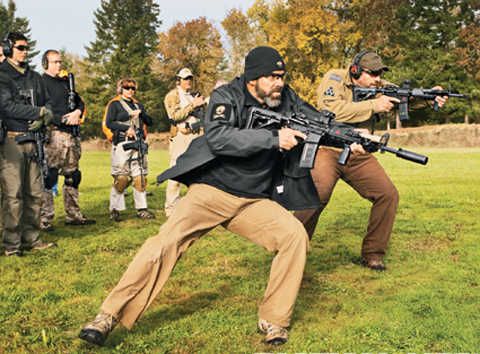
Little of the Magpul Dynamics course is standing on the flat range firing numbered shot counts. Students are taught to move, turn, problem solve and deliver accurate shots.
To check out the company that has sold more than 1.5 million polymer magazines and whose training division raised the bar on instructional videos with its Art of the Dynamic Carbine (1&2), Art of Dynamic Handgun and Aerial Platform Operations Series, TW stepped inside the Magpul Dynamics’ Dynamic Carbine Course in Hammond, LA to see if these guys are as good as their videos.
Dynamic Carbine 1: Building the Fundamentals
"We will give the students an honest snapshot of themselves, very quickly,” says Chris Costa, Magpul Dynamics Instructor. The Dynamic Carbine 1 course brought together shooters from across the country and throughout the range of shooting experience. There were several husband and wife attendees, a father and son, as well as law enforcement, hobbyists, and professional security contractors. After a detailed safety briefing, instructors Costa, Haley, and Olivella began building up the fundamentals in their students. Starting with basic body position, stance, and trigger control, the class moved to confirming zero on their optics. Once zeroed, in-depth work began on sight picture/sight alignment differences at ranges from 5 to 50 yards. Reload techniques such as speed (under fire), tactical (in action, but covered), and admin (no threat, get re-organized) were covered, as well as malfunction drills (double-feed, mag failure, mis-fire, stovepipe).
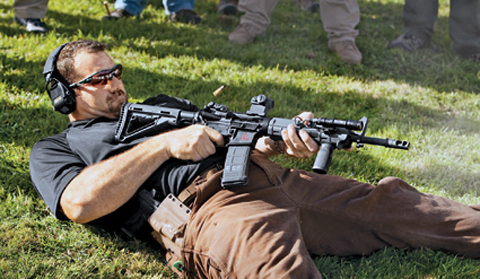
Instructor demonstrates the supine position. The position is a critical skill that allows shooter to tactically recover from a slip or dramatically reduce his profile while continuing to deliver well-aimed shots under fire.
As the course continued over the next three days, BSA drills (“Balance of Speed and Accuracy”) became a common element. The BSA drill measures timed rounds into an 8-inch center-mass circle on the man-sized Magpul targets. Students were encouraged to push their limits from standing, kneeling, and prone positions at varying distances. The targets told the tale: If the group was too tight with no hits outside the circle, speed was lacking. If the group was scattered outside the circle, the shooter should slow down and concentrate on body position and accuracy. This litmus test gave each student instant feedback at every drill as to how fast he/she could push the rifle and put combat-effective hits on the target.
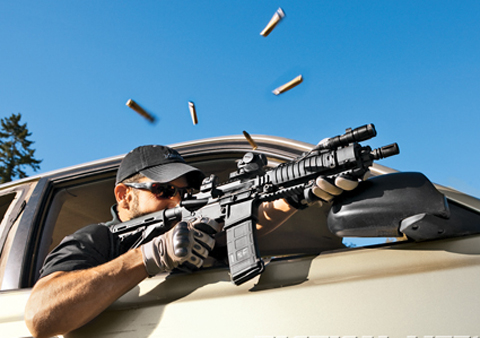
Magpul tests both decision making and weapons handling skills. Above, a student engages multiple targets from the open window of a vehicle.
On the afternoon of day two, the instructors conducted a “mini” handgun course. While the handgun is typically a class unto itself, the transition to the handgun in the event of a carbine malfunction at close range is a crucial skill and would become a part of many of our subsequent drills. Day three brought a significant increase in the pace of the drills, which now included weapons transitions, timed speed events, movement to multiple targets and barricade obstacle shooting. Dynamic Carbine 1 ended with shooters more confident, competent, and mindful than when they arrived.
BLOG ARCHIVES

Run the gun and your mind through Magpul’s high-speed, low-drag carbine course with today’s top tactical operators!

Little of the Magpul Dynamics course is standing on the flat range firing numbered shot counts. Students are taught to move, turn, problem solve and deliver accurate shots.
To check out the company that has sold more than 1.5 million polymer magazines and whose training division raised the bar on instructional videos with its Art of the Dynamic Carbine (1&2), Art of Dynamic Handgun and Aerial Platform Operations Series, TW stepped inside the Magpul Dynamics’ Dynamic Carbine Course in Hammond, LA to see if these guys are as good as their videos.
Dynamic Carbine 1: Building the Fundamentals
"We will give the students an honest snapshot of themselves, very quickly,” says Chris Costa, Magpul Dynamics Instructor. The Dynamic Carbine 1 course brought together shooters from across the country and throughout the range of shooting experience. There were several husband and wife attendees, a father and son, as well as law enforcement, hobbyists, and professional security contractors. After a detailed safety briefing, instructors Costa, Haley, and Olivella began building up the fundamentals in their students. Starting with basic body position, stance, and trigger control, the class moved to confirming zero on their optics. Once zeroed, in-depth work began on sight picture/sight alignment differences at ranges from 5 to 50 yards. Reload techniques such as speed (under fire), tactical (in action, but covered), and admin (no threat, get re-organized) were covered, as well as malfunction drills (double-feed, mag failure, mis-fire, stovepipe).

Instructor demonstrates the supine position. The position is a critical skill that allows shooter to tactically recover from a slip or dramatically reduce his profile while continuing to deliver well-aimed shots under fire.
As the course continued over the next three days, BSA drills (“Balance of Speed and Accuracy”) became a common element. The BSA drill measures timed rounds into an 8-inch center-mass circle on the man-sized Magpul targets. Students were encouraged to push their limits from standing, kneeling, and prone positions at varying distances. The targets told the tale: If the group was too tight with no hits outside the circle, speed was lacking. If the group was scattered outside the circle, the shooter should slow down and concentrate on body position and accuracy. This litmus test gave each student instant feedback at every drill as to how fast he/she could push the rifle and put combat-effective hits on the target.

Magpul tests both decision making and weapons handling skills. Above, a student engages multiple targets from the open window of a vehicle.
On the afternoon of day two, the instructors conducted a “mini” handgun course. While the handgun is typically a class unto itself, the transition to the handgun in the event of a carbine malfunction at close range is a crucial skill and would become a part of many of our subsequent drills. Day three brought a significant increase in the pace of the drills, which now included weapons transitions, timed speed events, movement to multiple targets and barricade obstacle shooting. Dynamic Carbine 1 ended with shooters more confident, competent, and mindful than when they arrived.
BLOG ARCHIVES

Posted by echigoyaworks
at 12:00
2012年07月21日
Smith & Wesson Bodyguards
私たちのブログを訪問していただきありがとうございます。あなたがお持ちの場合DIYの要求は私達に電子メールを送信してください。
Laser-equipped deep-cover .38 snubbie and .380 auto — ideal for back-up carry!

WHEN IT COMES TO HAVING A CORNER ON THE DEEP-COVER carry market, nobody beats out Smith & Wesson. Beginning with the “Chief’s Special,” an ultra-compact snubnose packing five rounds of .38 Special into the tiny J-frame package, the company created the basis for what would become the iconic deep-concealment revolver and back-up gun for law enforcement officers around the country.

An integrated Insight red laser sight assembly is located to the right rear of the cylinder on the Bodyguard 38.
With lightweight variants, differently chambered versions, and ones with longer barrels or different grips or different sights, it seemed that just about every variation of the design was developed for every conceivable contingency. However, at its core, the classic J-frame was a design from a different era, being first offered in the 1950s, and one that was both time-consuming and relatively expensive to manufacture.
Although sales were (and still are) extremely strong on the traditional J-frames, Smith & Wesson recognized that there was a need for the development of a radically modern deep-concealment revolver—one that took advantage of the most modern of materials and construction methods and that hit a lower retail price point.
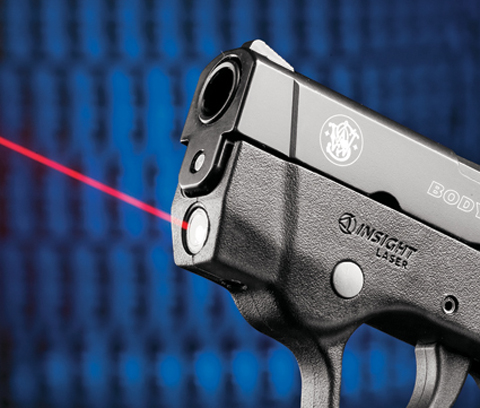
The Insight laser module of the 380 is internally located within the dustcover portion of the polymer frame. Note the light gray round activation button.
Concurrent with this realization was an acknowledgement on Smith & Wesson’s part of the extreme demand in the market for deep-concealment semi-autos chambered in .380 ACP that offered good power in a very small package. In response, the company began the process of developing what we now know today as the “Bodyguards”—a .38 Special revolver and .380 ACP sub-compact autopistol.
Laser-equipped deep-cover .38 snubbie and .380 auto — ideal for back-up carry!

WHEN IT COMES TO HAVING A CORNER ON THE DEEP-COVER carry market, nobody beats out Smith & Wesson. Beginning with the “Chief’s Special,” an ultra-compact snubnose packing five rounds of .38 Special into the tiny J-frame package, the company created the basis for what would become the iconic deep-concealment revolver and back-up gun for law enforcement officers around the country.

An integrated Insight red laser sight assembly is located to the right rear of the cylinder on the Bodyguard 38.
With lightweight variants, differently chambered versions, and ones with longer barrels or different grips or different sights, it seemed that just about every variation of the design was developed for every conceivable contingency. However, at its core, the classic J-frame was a design from a different era, being first offered in the 1950s, and one that was both time-consuming and relatively expensive to manufacture.
Although sales were (and still are) extremely strong on the traditional J-frames, Smith & Wesson recognized that there was a need for the development of a radically modern deep-concealment revolver—one that took advantage of the most modern of materials and construction methods and that hit a lower retail price point.

The Insight laser module of the 380 is internally located within the dustcover portion of the polymer frame. Note the light gray round activation button.
Concurrent with this realization was an acknowledgement on Smith & Wesson’s part of the extreme demand in the market for deep-concealment semi-autos chambered in .380 ACP that offered good power in a very small package. In response, the company began the process of developing what we now know today as the “Bodyguards”—a .38 Special revolver and .380 ACP sub-compact autopistol.
Posted by echigoyaworks
at 19:00
2012年07月21日
Arctic S.W.A.T
私たちのブログを訪問していただきありがとうございます。あなたがお持ちの場合DIYの要求は私達に電子メールを送信してください。
Last frontier lawmen protect 2,000 square miles of extreme country with cutting-edge weapons and tactics!
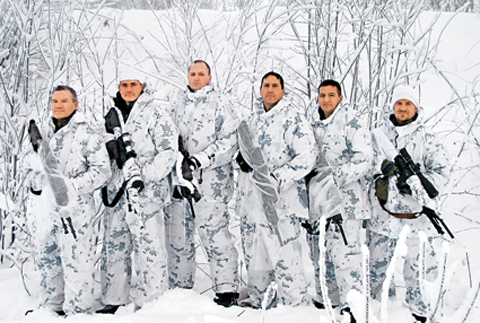
Members of the APD S.W.A.T. sniper team blend into their arctic surroundings with MARPAT overwhites. Knight’s Armament SR-25 MK 11 rifles are their main guns.
“APD, Channel One units, respond to an 11-5 in progress at 4501 Elmore Road. Complainant advises there is a bear charging their sliding glass door.”
That’s not an everyday call, but it’s not uncommon, either, when you’re a police officer in Anchorage, Alaska. I first saw Anchorage in March of 1978. I was a few years out of the Army and was trying to get hired as an Alaska State Trooper. I was blown away that the ice on the parking lot was still 2 inches thick, there was 2 feet of snow on the ground, and that it was 16 degrees. It was offset by the fact that I was in Alaska.
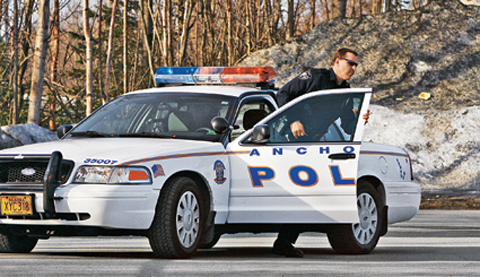
Anchorage officers are cross-trained to handle many duties. Strong community relations are a key tactic in helping to keep the peace.
Anchorage is policed by the Anchorage Police Department (APD). The Municipality of Anchorage is the largest in Alaska. The population of nearly 300,000 souls is almost half the population of the state, but 90 percent of the state’s residents use Anchorage as their transportation, shopping and recreation hub. Lots of rural residents come to town to see the lights, party a little too hard and need police services. Police calls are made more difficult when the temperature is -30, with a 10 mph wind blowing off the inlet. Summers are fairly short and intense; with 24 hours of daylight, Alaskans tend to ignore sleep, knowing they can catch up in December. It can result in long, hard workdays for the APD.
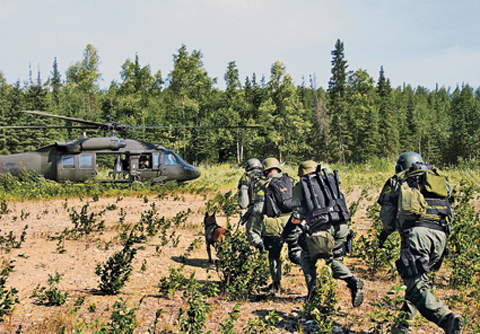
Anchorage S.W.A.T. practices mobile air operations with a Black Hawk helicopter, which they use to deploy to remote areas faster.
Since Anchorage is a “distance-isolated city in a distance-isolated state,” the APD relies on excellent police-community relations to accomplish the mission. There is constant demand for demonstrations from schools, youth groups and job fairs, and vehicles and K-9s are special hits with school kids. In order to maintain close public ties, the APD uses outreach teams, school resource officers and a citizen police academy to improve communication and cooperation; a volunteer Search Team helps find lost folks and search for evidence. The APD is also moving toward assigning officers to the same areas in an effort to form stronger community ties.
BLOG ARCHIVES

Last frontier lawmen protect 2,000 square miles of extreme country with cutting-edge weapons and tactics!

Members of the APD S.W.A.T. sniper team blend into their arctic surroundings with MARPAT overwhites. Knight’s Armament SR-25 MK 11 rifles are their main guns.
“APD, Channel One units, respond to an 11-5 in progress at 4501 Elmore Road. Complainant advises there is a bear charging their sliding glass door.”
That’s not an everyday call, but it’s not uncommon, either, when you’re a police officer in Anchorage, Alaska. I first saw Anchorage in March of 1978. I was a few years out of the Army and was trying to get hired as an Alaska State Trooper. I was blown away that the ice on the parking lot was still 2 inches thick, there was 2 feet of snow on the ground, and that it was 16 degrees. It was offset by the fact that I was in Alaska.

Anchorage officers are cross-trained to handle many duties. Strong community relations are a key tactic in helping to keep the peace.
Anchorage is policed by the Anchorage Police Department (APD). The Municipality of Anchorage is the largest in Alaska. The population of nearly 300,000 souls is almost half the population of the state, but 90 percent of the state’s residents use Anchorage as their transportation, shopping and recreation hub. Lots of rural residents come to town to see the lights, party a little too hard and need police services. Police calls are made more difficult when the temperature is -30, with a 10 mph wind blowing off the inlet. Summers are fairly short and intense; with 24 hours of daylight, Alaskans tend to ignore sleep, knowing they can catch up in December. It can result in long, hard workdays for the APD.

Anchorage S.W.A.T. practices mobile air operations with a Black Hawk helicopter, which they use to deploy to remote areas faster.
Since Anchorage is a “distance-isolated city in a distance-isolated state,” the APD relies on excellent police-community relations to accomplish the mission. There is constant demand for demonstrations from schools, youth groups and job fairs, and vehicles and K-9s are special hits with school kids. In order to maintain close public ties, the APD uses outreach teams, school resource officers and a citizen police academy to improve communication and cooperation; a volunteer Search Team helps find lost folks and search for evidence. The APD is also moving toward assigning officers to the same areas in an effort to form stronger community ties.
BLOG ARCHIVES

Posted by echigoyaworks
at 12:00
2012年07月20日
Locked, Loaded & Ready
私たちのブログを訪問していただきありがとうございます。あなたがお持ちの場合DIYの要求は私達に電子メールを送信してください。
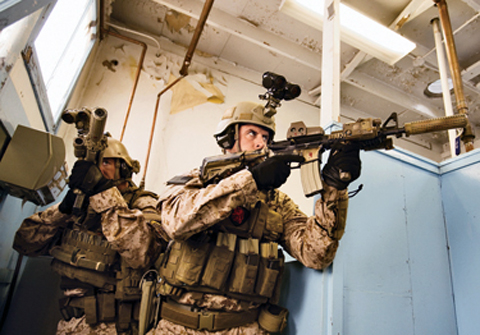
Like the U.S. Navy SEALs who are trained and have been deployed in a wide variety of missions, including direct action and special recon, unconventional warfare, counter-terrorism, and other missions, TW has your back!
French statesman Duc de Richelieu (1766-1822) was once reviewing a proposed military campaign. When an officer placed a finger on a map with the remark, “We shall cross the river at this point,” Richelieu replied, “Excellent, sir, but your finger is not a bridge.”
Grand plans and big talk are one thing; For the grand plan to survive the first contact with an enemy depends on the total readiness of the forces involved. Give the Duke credit: Even in that distant time, he knew his forces would have to be mission ready—with weapons, tactics and combat psyche.
Today’s military and LE operators routinely must meet mission readiness requirements, of which no soldier from Richelieu’s time could have dreamed. How today’s professionals are doing exactly that is the theme of this special “Mission Ready” edition of TW.
Individual firepower is always an important subject in TW, and this issue covers the topic particularly well. For openers, consider our testfire report on the new Remington Semi-Automatic Sniper System made in partnership with JPE and AAC. Another sniper testfire covers the Steyr SSG08 now available in .338 Lapua Magnum.
BLOG ARCHIVES


Like the U.S. Navy SEALs who are trained and have been deployed in a wide variety of missions, including direct action and special recon, unconventional warfare, counter-terrorism, and other missions, TW has your back!
French statesman Duc de Richelieu (1766-1822) was once reviewing a proposed military campaign. When an officer placed a finger on a map with the remark, “We shall cross the river at this point,” Richelieu replied, “Excellent, sir, but your finger is not a bridge.”
Grand plans and big talk are one thing; For the grand plan to survive the first contact with an enemy depends on the total readiness of the forces involved. Give the Duke credit: Even in that distant time, he knew his forces would have to be mission ready—with weapons, tactics and combat psyche.
Today’s military and LE operators routinely must meet mission readiness requirements, of which no soldier from Richelieu’s time could have dreamed. How today’s professionals are doing exactly that is the theme of this special “Mission Ready” edition of TW.
Individual firepower is always an important subject in TW, and this issue covers the topic particularly well. For openers, consider our testfire report on the new Remington Semi-Automatic Sniper System made in partnership with JPE and AAC. Another sniper testfire covers the Steyr SSG08 now available in .338 Lapua Magnum.
BLOG ARCHIVES

Posted by echigoyaworks
at 21:00
2012年07月20日
McMillan Tac .308
私たちのブログを訪問していただきありがとうございます。あなたがお持ちの場合DIYの要求は私達に電子メールを送信してください。
Designed for the professional marksman to perform in the harshest of conditions!

When one thinks of precision tactical rifles, one of the first names that come to mind is McMillan. McMillan has established a well-deserved reputation for manufacturing some of the highest quality and most accurate rifles on the planet.
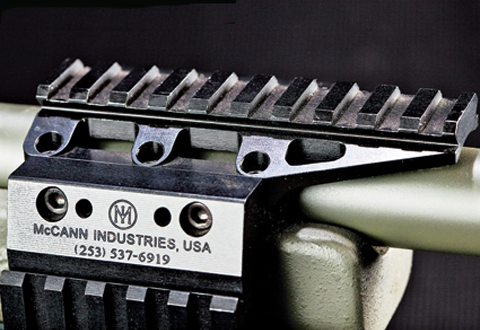
The TAC-308 came equipped with a McCann Industries forward rail system to offer even more “real estate” for accessories.
McMillan manufactures a complete line of rifles for sport shooters, competitive shooters and military or law enforcement marksmen. If a standard McMillan rifle doesn’t meet customer requirements, the company will build a rifle that does. All rifles include a McMillan custom pillar-bedded fiberglass stock, a match-grade stainless steel barrel and Remington type trigger, and are finished in DuraCoat, a durable wear-resistant polymer.
The McMillan TAC-308 Tactical Rifle uses their “top of the line” G30 action, built by the company to aerospace standards, with each action CNC-machined from a solid billet. The action material is 17-4 stainless steel, which is tougher and more corrosion resistant than the 4000-series alloy often encountered in firearms. The steel is hardened to 42-43 Rockwell C. The action face is absolutely perpendicular to the bolt axis. General tolerances are held to 0.005 of an inch, while critical components are machined to 0.0005 of an inch. The chamber and barrel threads are cut to critical tolerances and then hand-fitted.

All McMillan barrels are premium, hand-lapped, match-grade stainless steel, capable of delivering exceptional performance. A removable cap protects the rifle’s threaded muzzle (shown) that can accept a variety of suppressors or muzzle brakes.
BLOG ARCHIVES

Designed for the professional marksman to perform in the harshest of conditions!

When one thinks of precision tactical rifles, one of the first names that come to mind is McMillan. McMillan has established a well-deserved reputation for manufacturing some of the highest quality and most accurate rifles on the planet.

The TAC-308 came equipped with a McCann Industries forward rail system to offer even more “real estate” for accessories.
McMillan manufactures a complete line of rifles for sport shooters, competitive shooters and military or law enforcement marksmen. If a standard McMillan rifle doesn’t meet customer requirements, the company will build a rifle that does. All rifles include a McMillan custom pillar-bedded fiberglass stock, a match-grade stainless steel barrel and Remington type trigger, and are finished in DuraCoat, a durable wear-resistant polymer.
The McMillan TAC-308 Tactical Rifle uses their “top of the line” G30 action, built by the company to aerospace standards, with each action CNC-machined from a solid billet. The action material is 17-4 stainless steel, which is tougher and more corrosion resistant than the 4000-series alloy often encountered in firearms. The steel is hardened to 42-43 Rockwell C. The action face is absolutely perpendicular to the bolt axis. General tolerances are held to 0.005 of an inch, while critical components are machined to 0.0005 of an inch. The chamber and barrel threads are cut to critical tolerances and then hand-fitted.

All McMillan barrels are premium, hand-lapped, match-grade stainless steel, capable of delivering exceptional performance. A removable cap protects the rifle’s threaded muzzle (shown) that can accept a variety of suppressors or muzzle brakes.
BLOG ARCHIVES

Posted by echigoyaworks
at 16:00
2012年07月20日
U.S. Ordnance MK43
私たちのブログを訪問していただきありがとうございます。あなたがお持ちの場合DIYの要求は私達に電子メールを送信してください。
Next-gen M60 general-purpose machine gun—lighter and faster
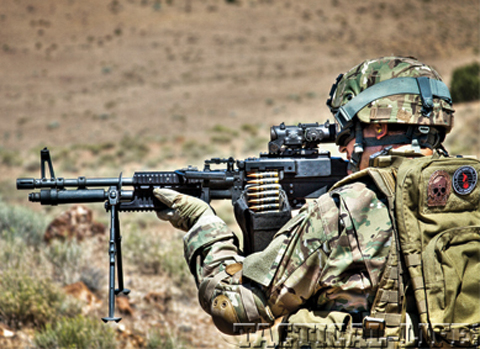
The U.S. Ordnance MK43 represents 22 key improvements on the M60 base model, cutting redundant parts and creating a lighter, more accurate machine gun that can produce a superior volume of fire downrange.
When most think of a machine gun, they picture a weapon supported by a bipod or fixed mount being fired by one man as others pass ammunition. The U.S. Ordnance MK43 Mod 1, a 7.62×51mm General Purpose Machine Gun (GPMG), changes this view by giving soldiers a fully automatic belt-fed weapon designed specifically to be shouldered and fired from off-hand, kneeling and prone positions by a lone shooter. The MK43 represents the latest improvement to the M60 series of machine guns to which it belongs.
First introduced in 1957, the M60 has seen service with every branch of the U.S. military, and remains in their arsenals over 50 years later. Since the late-1970s, however, its dominance has steadily declined as the M240 was phased in as a more reliable and easier to maintain weapon despite its higher cost and solider complaints about its heavier weight. U.S. Ordnance is looking to change this trend with the MK43, which maintains the familiar design of the M60 while addressing the negative issues of preceding models. A modified M60E4, all of the MK43’s major components are directly interchangeable with other M60 configurations, and older weapons can be converted to the updated design by an armorer within 30 minutes without any requirement for complex tools or machines.
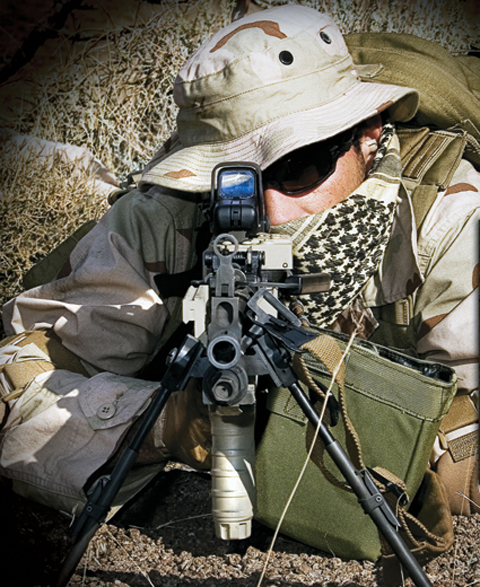
M60 Reborn
Available in both ground and mounted configurations, the MK43 is a gas-operated, disintegrating link, belt-fed and air-cooled medium machine gun that fires from an open bolt. Weighing only 20.61 pounds with its long barrel, the weapon is lighter than its predecessors and its M240B competition, and has an associated smaller length, ranging between 37.7 inches to 42.4 inches overall depending on barrel selection. The weapon’s cyclic rate of fire is 500 rounds per minute with a muzzle velocity of 2,800 FPS. Its maximum range is 4,075 yards and its effective range is 1,200 yards.
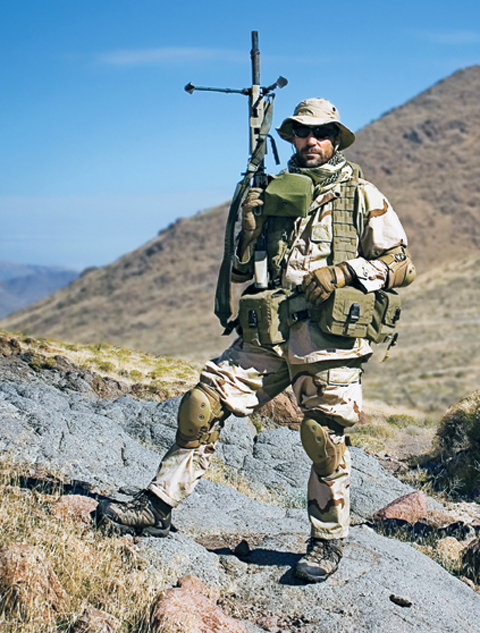
Light and compact, the MK43 provides increased mobility and uniquely allows for accurate, controllable off-hand shooting.
BLOG ARCHIVES

Next-gen M60 general-purpose machine gun—lighter and faster

The U.S. Ordnance MK43 represents 22 key improvements on the M60 base model, cutting redundant parts and creating a lighter, more accurate machine gun that can produce a superior volume of fire downrange.
When most think of a machine gun, they picture a weapon supported by a bipod or fixed mount being fired by one man as others pass ammunition. The U.S. Ordnance MK43 Mod 1, a 7.62×51mm General Purpose Machine Gun (GPMG), changes this view by giving soldiers a fully automatic belt-fed weapon designed specifically to be shouldered and fired from off-hand, kneeling and prone positions by a lone shooter. The MK43 represents the latest improvement to the M60 series of machine guns to which it belongs.
First introduced in 1957, the M60 has seen service with every branch of the U.S. military, and remains in their arsenals over 50 years later. Since the late-1970s, however, its dominance has steadily declined as the M240 was phased in as a more reliable and easier to maintain weapon despite its higher cost and solider complaints about its heavier weight. U.S. Ordnance is looking to change this trend with the MK43, which maintains the familiar design of the M60 while addressing the negative issues of preceding models. A modified M60E4, all of the MK43’s major components are directly interchangeable with other M60 configurations, and older weapons can be converted to the updated design by an armorer within 30 minutes without any requirement for complex tools or machines.

M60 Reborn
Available in both ground and mounted configurations, the MK43 is a gas-operated, disintegrating link, belt-fed and air-cooled medium machine gun that fires from an open bolt. Weighing only 20.61 pounds with its long barrel, the weapon is lighter than its predecessors and its M240B competition, and has an associated smaller length, ranging between 37.7 inches to 42.4 inches overall depending on barrel selection. The weapon’s cyclic rate of fire is 500 rounds per minute with a muzzle velocity of 2,800 FPS. Its maximum range is 4,075 yards and its effective range is 1,200 yards.

Light and compact, the MK43 provides increased mobility and uniquely allows for accurate, controllable off-hand shooting.
BLOG ARCHIVES

Posted by echigoyaworks
at 10:00



